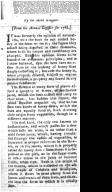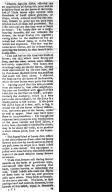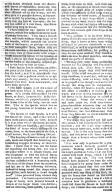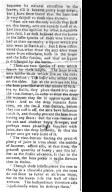[ Observations on the Origin of Honey ] Abbe Bouffier
Date: 1789/12/01
Source:
Nova Scotia Magazine
Institution: Nova Scotia Archives
| Source Origin: Nova Scotia Newspapers on Microfilm
| Reference: Microfilm Reels 8062, 8063
On the kinds of ready-made honey bees collect from honey dew. nn.427-29. Microfilm Reel 8063. Originally published in The Annual Register for the Year 1768, 6th Edition, as "A curious and interesting Account of a Substance, not before attended to, which the BEES collect and turn to honey. Extracted from a Memoire read before the Society of Science at Montpelier, by the Abbe Bouffier de Sauvages, entitled, Observations sur l'Origine du Miel," p. 95 (London, 1800).
By the Abbé Bouffier
[From the Annual Register for 1768.]
IT was formerly the opinion of natural-
ists, that the bees do not collect ho-
ney in the form we see it; the liquor they
collect being digested in their stomachs,
where both its nature and consistency are
changed. But this opinion seems to be
founded on erroneous principles; and it
is now believed, that the bees have no o-
ther share in the making of honey than
simply collecting it; because the honey is,
when properly diluted, subject to vinous
fermentation, a property not found in any
animal substance.
The flowers of many sorts of plants af-
ford a quantity of honey, of saccharine
juice, which the bees collect and carry to
their hives; but besides this liquor, the
Abbé Bouffier acquaint us, that he has
seen two kinds of honey dews, which the
bees are equally fond of, both deriving
their origin from vegetables, though in a
different manner.
The first kind, the only one known to
husbandmen, and which passes for a dew
which falls on trees, is no other than a
mild sweet juice, which, having circula-
ted through the vessels of vegetables, is
separated in proper reservoirs in the flow-
ers, or on the leaves, where it is properly
called the honey dew: Sometimes it is de-
posited in the pith, as in the sugar-cane,
at other times in the juice of summer
fruits, when ripe. Such is the origin of
the manna, which is collected on the ash
and maple of Calabria and Briançion,
where it glows in great plenty from the
leaves and trunks of these trees, and thick-
ens into the form in which it is usually
seen.
‘Chance, says the Abbé, afforded me
an opportunity of seeing this juice and its
primitive form on the leaves of the holm-
oak: These leaves were covered with
thousands of small round globules, or
drops, which, without touching one ano-
ther, seemed to point out the pore from
whence each of them had proceeded. My
tasted informed me that they were as sweet
as honey: The honey-dew on a neigh-
bouring bramble, did not resemble the
former, the drops having run together;
owing either to the moisture of the air
which had diluted them, or to the heat,
which had expanded. The dew was be-
come more viscous, and lay in large drops
covering the leaves; in this form it is u-
sually seen.
‘The oak had at this time two kinds of
leaves; the old, which were strong and
firm, and the new, which were tender,
and newly come forth. The honey-dew
was found only on the old leaves, though
these were covered by the new ones, and
by that means sheltered from any moisture
that could fall from above. I observed
the same on the old leaves of the bramble,
while the new leaves were quite free from
it. Another proof that this dew proceeds
from the leaves is, that other neighbour-
ing trees not furnished with a juice of this
kind, had no moisture on them; and par-
ticularly the mulberry, which is a very
particular circumstance, for this juice is a
deadly poison to silk worms. If this juice
fell in the form of a dew, mist, or fog, it
would wet all the leaves without distinc-
tion, and ever part of the leaves, under
as well as upper. Heat may have some
share in this production: For though the
common heat promotes only transpiration
of the more volatile and fluid juices, a
sultry heat, especially if reflected by clouds,
may so far dilate the vessel, as to produce
a more viscous juice, such as the honey-
dew.
‘The second kind of honey-dew, which
is the chief resource of bees after the spring
flowers and few by transpiration on leaves
are past, owes its origin to a small insect
called a vine-fretter: The excrement e-
jected with some force by this insect makes
a part of the most delicate honey known
in nature.
'These vine-fretters rest during several
months on the barks of particular trees,
and extract their food by piercing that
bark, without hurting or deforming the
tree. These insects also cause the leaves
of some trees to curl up, and produce
galls upon others. They settle on branch-
es that are a year old. The juice, at first
perhaps hard and crabbed, becomes, in the
bowels of this insect, equal in sweetness
to the honey obtained from the flowers
and leaves of vegetables; excepting that
the flowers may communicate some of
their essential oil to the honey, and this
may give it a peculiar flavour, as happen-
ed to myself by planting a hedge of rose-
mary near my bees at Sauvages; the ho-
ney has tasted of it ever since, that shrub
continuing long in flower.
‘I have observed two species of vine-
fretters, which live unsheltered on the bark
of young branches: They have a smooth
skin, and those without wings seem to be
the females, which compose the greater
bulk of the swarm; or perhaps the young
in their caterpillar state, before they are
changed into flies; for each swarm has, in
its train, two or three males with wings:
these live on the labour of the females, at
least I always saw them hopping carelessly
on the backs of the females, without go-
ing to the bark to seek for food.
‘Both species live in clusters, on differ-
ent parts of the same tree, entirely cover-
ing the bark; and it is remarkable that
they there take a position which to us ap-
pears very uneasy; for they adhere to the
branch with their head downwards, and
their belly upwards.
‘The lesser species is of the colour of
the bark upon which it feeds, generally
green. It is chiefly distinguished by two
horns, or strait, immoveable, fleshy sub-
stances, which rise perpendicularly from
the lower sides of the belly, one on each
side. This is the species which live on
the young branches of brambles and el-
der.
‘The former of these species is double
the size of the latter, and is that which I
have more particularly in view, because
it is that from which the honey proceeds.
These insects are blackish; and instead of
the kind of horns which distinguish the
other, have, in the same part of the skin, a
small button, black, and shining like jet.
‘The buzzing of bees in a tuft of holm-
oak, made me suspect that something very
interesting brought so many of them thi-
ther. I knew that it was not the season
for expecting the honey-dew, nor was it
the place where it is usually found, and
was surprized to find the tuft of leaves
and branches covered with drops which
the bees collected with a humming noise.
The form of the drops drew my attention,
and led me to the following discovery.
Instead of being round like drops which
have fallen, each formed a small longish
oval. I soon perceived from whence they
proceeded. The leaves covered with these
drops of honey were situated beneath a
swarm of the larger black vine-fretters;
and on observing these insects, I perceived
____
them, from time to time, raise their bel-
lies, at the extremity of which there then
appeared a small drop of amber colour,
which they instantly ejected from them to
the distance of some inches. I found by
tasting some of these drops which I had
catched on my hand, that it had the same
flavour with what had before fallen on the
leaves. I afterwards saw the smaller spe-
cies of vine fretters eject their drops in the
same manner.
‘This ejection is so far from being a
matter of indifference to these insects them-
selves, that it seems to have been wisely
instituted to procure cleanliness in each
individual, as well as to preserve the whole
swarm from destruction; for pressing as
they do one upon another, they would o-
therwise soon be glued together, and ren-
dered incapable of stirring.
‘We may now with some probability
account for the seeming odd situation in
which they rest. Their belly is about
twenty times larger than their head and
breast. If the insect was placed on a con-
trary direction, it could not, without ex-
treme difficulty, raise its heavy belly, so
as to project it far enough outward to dis-
charge the drop over its companions;
whereas, when the head is lowest, much
less effort is necessary to incline [it] for-
ward; and even in this situation the in-
sect seems by its flutterings to collect all
its strength. When the winter’s cold
and rains come on, these vine-fretters
place themselves wherever they are least
exposed; and as they then take but little
nourishment, and but seldom emit their
drop, they seem not to mind whether the
head or tail be uppermost.
‘The drops thus spurted out fall upon
the ground, if not intercepted by leaves or
branches; and the spots they make on
stones remain some time, unless washed off
by rain. This is the only honey-dew that
falls; and this never falls from a greater
height than a branch where these insects
can clutter.
‘It is now easy to account for a phae-
nemenon which formerly puzzled me
greatly. Walking under a lime-tree in
the king’s garden at Paris, I felt my hand
wetted with little drops, which I at first
took for small rain. The tree indeed
should have sheltered me from the rain,
but I escaped it by going from under the
tree. A seat placed near this tree shone
with these drops. And being then unac-
quainted with any thing of this kind, ex-
cept the honey-dew found on the leaves
of some particular trees, I was at a loss to
conceive how so glutinous a substance
could call from the leaves in such small
drops; for I knew that rain could not o-
vercome its natural attraction to the
leaves, till it became pretty large drops;
but I have since found that the lime-tree
is very subject to these vine-fretters.
‘Bees are not the only insects that feast
on this honey, ants are equally font of it.
Led into this opinion by what naturalists
have said, I at first believed that the horns
in the lesser species of these vine fretter,
had at their extremity a liquor which the
ants went in search of: But I soon disco-
vered that what drew the ants after them
came from elsewhere, both in the larger
and lesser species, and that no liquor
is discharged by the horns.
‘There are two species of ants which
search for these insects. The large black
ants follow those which live on the oaks
and chesnut: The lesser ants attend those
on the elder. But as the ants are not like
the bees provided with the means of suck-
ing up fluids, they place themselves near
the vine-fretters, in order to seize the drop
the moment they see it appear upon the
anus: And as the drop remains some
time, on the small vine-fretters, before
they can cast it off, the ants have leisure to
catch it, and thereby prevent the bees from
having any share: But the vine-fretters of
the oak and chesnut being stronger, and
perhaps more plentifully supplied with
juice, dart the drop instantly, so that the
larger ants get very little of it.
‘The vine-fretters finding the greatest
plenty of juice in trees about the middle
of summer, afford also, at that time, the
greatest quantity of honey; and this les-
sens as the season advances, so that in the
autumn, the bees prefer it to the flowers
then in season.
‘Though these insects pierce the tree to
the sap in a thousand places, yet the trees
do not seem to suffer at all form them,
not do the leaves lose the least of their
verdure. The husbandman therefore acts
injudiciously when he destroys them.’
Download: Transcription | Images



